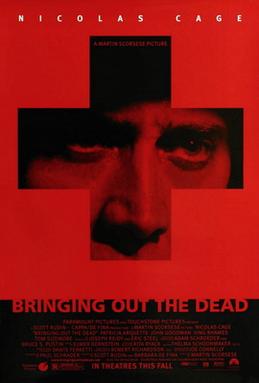Scorcese’s 'Bringing Out The Dead'


Recall Travis Bickel’s mustardy yellow taxi cruising malevolently through mounds of manhole steam in Martin Scorcese’s 1976 “Taxi Driver?” Then experience another chariot of death, this time a wildly lurching paramedic ambulance, driven by a manic Nicholas Cage, trapped in an unending series of rescue missions into a hellish New York underworld. This is Scorcese’s equally bleak but equally unforgettable “Bringing Out The Dead” (1999) — an overlooked and under appreciated film all the more relevant in today’s Covid-times.
“Bringing Out The Dead” is written by Paul Schrader, the intense, brilliant screenwriter with whom director Scorcese also partnered in “Taxi Driver” and “Raging Bull” (and who gave us 2018’s searing “First Reformed,” with Ethan Hawke as a tormented upstate pastor). Schrader and Scorsese, a former Calvinist and a lapsed Catholic, share an affinity for tragic, driven characters, haunted by a vaguely recognized religious yearning.
The tight script is made vivid by the sharp cuts and careful splices of long-time Scorcese editor and associate Thelma Schoonmacher. And the dark themes are given visual form by the film’s striking nighttime cinematography — neon sidestreet exteriors and fluorescent hospital interiors — by three-time Oscar winner Robert Richardson, a veteran collaborator with Quentin Tarantino and Oliver Stone as well as with Scorcese.
Nicholas Cage, when fully engaged in a role can be one of the screen’s most electrifying actors — witness “Moonstruck,” “Raising Arizona”, “Face/Off,” “Bad Lieutenant: New Orleans,” and “Leaving Las Vegas” (for which he won a 1995 Academy Award). Here he gives a gripping, over-the-top performance as Frank Pierce, an ambulance driver driven mad by the unavoidable chaos of his job — his despair at being seldom able to save any of his gunshot, stabbed, or drug-overdosed patients. His manic-depressive, tormented voice-overs reveal his anguish: with the idea of “spirits leaving the body, but not wanting to return,” with the realization that sooner or later “we’re all dying.”
The film is structured around three hellish nights on the late-night-shift, in which Cage partners with three different, indelibly-drawn characters. John Goodman is Larry, disguising his torment with booze, cheap takeout, and humor. Ving Rhames is the cigar-chomping part-time preacher Marcus. And Tom Sizemore is Tom Wolls, even more truly unhinged than Frank, who thinks nothing of savagely beating patients he is sent to save. The film’s most classic scene is a wild-eyed Frank behind the wheel, cackling insanely at an astonished and admiring Tom, stripping gears and steering wildly, careening out of control down city streets through red lights and scrambling pedestrians.
As a counterpoint to the madness, in an equally fine-drawn performance, Patricia Arquette is Mary Burke, daughter of one of Frank’s patients, who alternates between unrealistic highs of optimism and drug-ridden depths of despair. But it is she who in the end, channeling one of Frank’s failed rescues, makes him realize that “no one told you to suffer — that was your idea.” And with that absolution, the film closes with a shimmering, Piéta-like image of Frank asleep in Mary’s arms, finally at peace.
A grim but ultimately positive tale — befitting the subject matter, with all too close relevance to the city’s recent Hades, the mental and physical toll paid by our courageous, exhausted first responders, but with the hope that this too will pass.
Streaming is a periodic look at classic films, available on home networks and apps. “Bringing Out the Dead” can be found on Amazon Prime, iTunes, Vudu, and Google Play.



